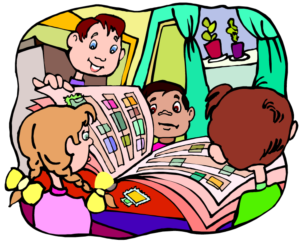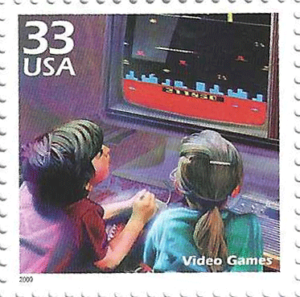When my children were in the 8- to 12-year-old range, each one in turn tried stamp collecting. Three of the four even did exhibits. They did not have to be cajoled into it by a  clearly involved helicopter father. Rather they were, I think, curious what I found so attractive, and got involved through participation in a Ben Franklin Stamp Club established at their school (a system the USPS sponsored nationwide, providing a monthly multi-color newsletter and other support materials such as membership cards, etc.). I was the adult sponsor for the local school’s club.
clearly involved helicopter father. Rather they were, I think, curious what I found so attractive, and got involved through participation in a Ben Franklin Stamp Club established at their school (a system the USPS sponsored nationwide, providing a monthly multi-color newsletter and other support materials such as membership cards, etc.). I was the adult sponsor for the local school’s club.
Unfortunately, the hobby did not stick with them. And I can list several reasons why not. First, while there were lots of stamps available to collect, and they were all given free. And yet, one of the major areas of interest they had about stamps was their value. I contrast this to my earliest years in the hobby, where the value of my collection was the last thing on my mind.
Now, by the time I was 12, and going to club meetings with my father, I was spending my paltry allowance on stamps. But I was a confirmed collector, and my concern was in filling the blanks in my album, not with what I might get if I sold the stamps.
 Some might fault me for allowing my kids to grow up thinking about possessions in monetary terms, but I contend that by the 1980s, the social fabric of our country was intensely intertwined with money and its value/what it could buy. We have in fact bred generations of children who have grown up with ever increasingly targeted advertising, telling kids what they should have; a relative rarity in the days when I grew up with a ten-inch, black-and-white TV screen.
Some might fault me for allowing my kids to grow up thinking about possessions in monetary terms, but I contend that by the 1980s, the social fabric of our country was intensely intertwined with money and its value/what it could buy. We have in fact bred generations of children who have grown up with ever increasingly targeted advertising, telling kids what they should have; a relative rarity in the days when I grew up with a ten-inch, black-and-white TV screen.
So, in this day of $200 sneakers, $75 jeans being sold new with ripped knees, must-have electronics, and designer tops for kids that adults can’t afford, is it any wonder that money is high on the radar screens of kids who are probably not told enough, “No, we can’t afford that!”?
The result is that kids have learned to monetize everything. And when they learn that their entry-level collection is essentially worthless, a reasonable question is “Why do I want to be involved in this?”
That phenomenon was just beginning to kick in when my kids were approaching their teenage years. Also kicking in was the advent of a wider range of TV channels, and one of the great time-wasters of the 20th century, TV video games. My kids were far more interested in how high they could score playing Pacman and the immediate feedback that offered, than in spending time on the laborious process of building a stamp collection; which offered no element of competition among their peers, and little in the way of immediate feedback.
Yes, there was some enjoyment in trading stamps with their friends, but nothing compared to the status gained in the ‘friend community’ by playing Pac-man well.
If anything, this challenge to our hobby has increased exponentially with the multiplicity of electronic gadgets, and the ability to communicate instantaneously with friends and acquaintances; now with both words and images. Stamp collecting could be addictive if one got serious about it, but today’s electronic gizmos are both instantaneously addictive, and the social pressure to engage in using them is enormous.
One of my grandchildren said to me a couple of weeks ago “Grandpa, you may know the basics of how to use your iPhone, but you really need to take a course to understand the power it has and the things it can do.” My reaction is that I don’t want to get involved in
additional functionality. I already spend more time on it than I find comfortable. But I, like them I suspect, can’t seem to help myself! And they are pressured by their peers to obtain and use the most recent gadgets and their full power.My observation of the behavior of my grandkids, who range from 2-years old to 21 years, is that they spend so much time with their noses buried in their electronic devices it is a wonder they have time to eat or do homework. There is just no time for working with physical objects like stamps.
We did it as kids because we had time on our hands, with few other distractions, and we enjoyed the act of organizing our collection, and the pride of learning about other nations and American history from stamps.
The other thing we enjoyed was sharing the hobby with others in our circle. With the Postal Service’s murder of its Ben Franklin Stamp Clubs in the early 1990s, it became increasingly unusual for kids to find other kids who collect. Why did they kill the BFSC? The proximate costs of developing collectors for the future were not being covered by young people buying stamps. So the program was a net financial loss, and the bean counters insisted that the budgeting process could not justify those costs. Guess they never heard of what private industry knows as “loss leaders.”
So, the practical result was that more than ever before, kids were suddenly reliant for support on adults; but how to find an adult collector if kids develop an interest? This makes the network of local clubs especially important. But keep in mind that available evidence is that the number of adult collectors has been falling in this country for many years if measured by numbers involved in organized philately, and subscription numbers for philatelic periodicals. There may still be a lot of collectors, but it seems a good share of them are lone wolves; not being involved in local philately, and not available to be mentors.
Add to this that, regrettably, all adults are now suspect; so much so that formal mentoring programs for their own protection are vetting mentor applicants against law enforcement data bases. Parents without that resource are often not pleased with the thought of having their child interacting with an adult stamp collector that they don’t know.
Then there is the cost of the hobby, which has been on an upward curve for many years. Stamp collecting implements such as catalogs and albums (with thousands more stamps being issued worldwide each year) are beyond the reach of most kids’ allowances. The cost of a first-class mint stamp has gone from 3 cents when I was a kid to 58 cents today, and the number of issues and postal products has mushroomed. I tend to discount this as a major reason for kids dropping out for two reasons: First, the actual cost of a year of single US mint stamps is still way less than a pair of stylish sneakers, a couple of trips to the movies, or a few meals out at your local fast food outlet.
Second, as they make a fine and relatively inexpensive gift for parents and grandparents to give, mint US stamps need not be beyond the reach of kids. But the adults must be willing to navigate the USPS Internet ordering system, as limited numbers of commemoratives, and sometime none at all, are available from local post offices.
These phenomena are driving kids in the direction of used stamps, and I would have no great problem with this; in fact, it could be a positive, but it isn’t. Why? Used is less expensive, but more difficult to acquire; not to mention more difficult to store and house in an album because they can no longer be soaked free of the paper they went through the mail on. And there is another major problem that has been developing for the last 40 years: Though a few remain, local stamp stores have gone the way of the Dodo, stamp clubs are not thriving for the most part, buying used stamps from dealers by email is complicated, and the Postal Service in its zeal to keep collectors from clogging the lines at local post offices has done everything possible to push collectors to buy their wants on the Internet.
This has the predictable effect of keeping commemoratives off daily mail. So, current stamps, which should be a major focus for kids who get many of their stamps from friends and family, get little more than the current definitives from those sources.
No one set out to make collecting more difficult for kids. We are dealing with 50 years of actions and phenomena that have had a deadly set of unintended consequences.
And some of those consequences are also affecting adult collectors and dampening our ardor for stamp collecting. Do we just lie down on the tracks and let the train run over us?
Should you wish to comment on this editorial, or have questions or ideas you would like to have explored in a future column, please write to John Hotchner, VSC Contributor, P.O. Box 1125, Falls Church, VA 22041-0125, or email, putting “VSC” in the subject line.
Or comment right here.






In reading your article I am reminded that my father collected exclusively US stamps for forty years. One day he announced to me that he was no longer collecting. I asked him why and he responded that it was becoming too expensive. I have found myself ( at 74 years old) in a simular dilema. Is the Post Office dept shooting itself in the foot? I realize revenue is needed to cover the costs of operation and the retirement plans. Toomany issues are being issued annunally along with groups of 10, 6, 4 stamp groupings. Offer only digital issues and omit regular FDC. My joy is in collecting and not monetary appreciation. My father had gone from buying mint sheets of every issue to buying plate blocks only.
Why not change how and what you collect? Your father changed from mint sheets (50 to 100 stamps) to plate blocks (usually 4). Instead of collecting every issue, why not decide just to collect commemoratives? Historical subjects? First-class letter-rate only? The USPS notices what sells and what doesn’t. Eid sells, Cinco de Mayo didn’t, so we get new Eid stamps every few years, but no more Cinco de Mayo (last one 1999).
What are the seeds of change that grow into an improved outlook for stamps? I began collecting about 6 months ago and live in a smaller town of 100k…and I am finding this to be quite solitary…aside from an occasional exchange with an eBay seller.
Thanks to the Internet, there are now many opportunities to make stamp collecting less “solitary:” Message boar ds like this one, Facebook groups, and Zoom seminars/discussions. The Virtual Stamp Club has a Facebook group, http://www.facebook.com/groups/virtualstampclub/ and there are some active ones for specialties like first day covers and topical (subject) collecting. Facebook also has groups for just buying and selling.
I developed a classroom version of stamp collecting based on the fourth grade study of the United States. The five session program is usually offered once a month from September through January. We developed a relationship with another classroom in another state to facilitate the collection of postmarks from all 50 states. We learned about geography, how the subject of a stamp is chosen, how to write relatives in other states and the armed forces and enhance interpersonal skills in trading postmarks so each child has a full set. Using an outside volunteer to present and organize the sessions makes it more interesting for the children. Free, used stamps are a great way to peak the interest in stamps for kids .